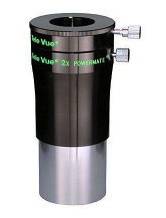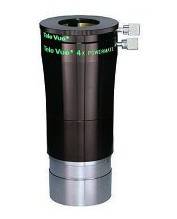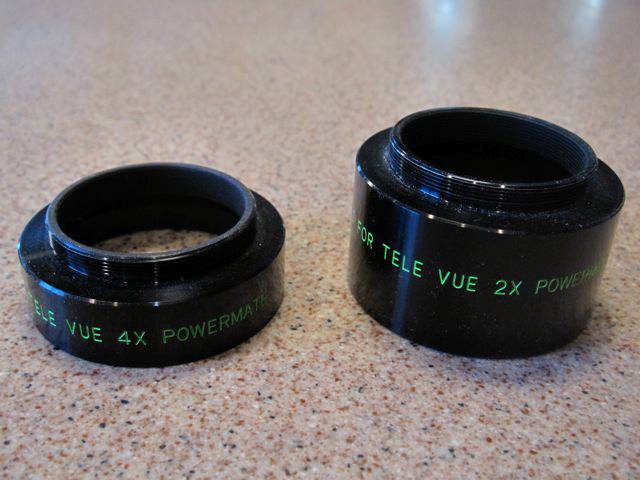



The Televue Powermates are a new concept for increasing the magnification (i.e., focal length) of a scope, so that small objects (e.g., planets) can be imaged with more resolution. Of course, the "power" of a scope is limited by atmospheric conditions; however, the Powermates basically create a larger image that spans more pixels of the CCD camera, so that the pixel resolution is better - which may or may not result in a better image, depending on conditions. The traditional approach is to use a "Barlow" lens - which typically increases the focal length of a scope by 2X, 3X, or 4X. The Televue Powermates are available in 2.5X and 5X for the 1.25" versions, and 2X and 4X for the 2" versions, which I have. They also include a special spacer T-ring to position the Powermate the appropriate distance from the CCD camera (see photo below). Note that the Powermates attach to the CCD camera via a standard T-thread. As these are only 41 mm in diameter, they will introduce vignetting with a CCD chip larger than the APS size (roughly 15 mm in diameter, or about 21 mm diagonal). The full-frame (24x35 mm) CCD cameras have a diagonal of more than 42 mm, so a T-thread used with these would certainly vignette the image (although this may not be very important, if only the central portion of the image is to be used - for example in imaging very small deep space objects, or planets). |
 |
I do not yet have photos of my 2X and 4X (2") Powermates (generic Televue photos are shown at the top of this page). However, the above photo shows the T-ring adapters specifically made for each of the Powermates. The upper barrel of the Powermate unscrews (don't try this with most other eyepieces!) and the T-ring adapter screws onto the eyepiece. The T-ring adapter than has T-threads for connection to a typical CCD camera (e.g., the SBIG ST-series). Alternatively, a lowcost T-ring can be purchased to adapt the T-threads to any standard camera lens thread - such as Nikon. While other adapters could be used to convert the T-threads to other lens mounts (e.g., C-mount), care must be taken, as the Powermate rings are sized to properly space the Powermate lens from the CCD camera chip; if this distance changes significantly, it may be difficult to achieve focus, or - even if well-focused - the image may not be optimum (i.e., have distortions). I have not yet used the Powermates for imaging -only for visual work. I look forward to doing some planetary imaging. I may also try using my STL camera with the Powermates, by using a Nikon T-ring to connect to the Powermate adapter, and then an STL Nikon mount to hook-up the T-ring. As noted previously, this system would be expected to vignette, but it would also provide, for example, 4X the focal length - or about 13,000 mm for the 12" LX200R! As the plate scale is 206*PixelSize(microns)/FocalLength(mm), the resulting plate scale with my STL-11000M would be about 0.14 arcseconds. As Jupiter has an angular diameter of 30-50 arcseconds, and Saturn has an angular diameter of 15-21 arcseconds, this would correspond to about 200-300 pixels square for Jupiter and 90-120 pixels square for Saturn, which allows a reasonable amount of detail. (Compare this with using the 12" LX200R at its native focal length of 3200 mm - which would result in resolution of only 50-75 pixels square for Jupiter and 15-20 pixels square for Saturn). Now you can see why the resolution of a webcam - typically 640x480 pixels - can be sufficient for planetary imaging. |